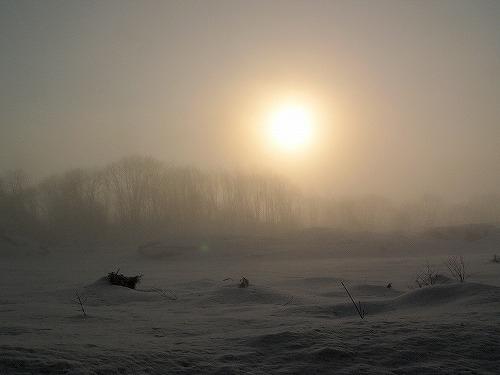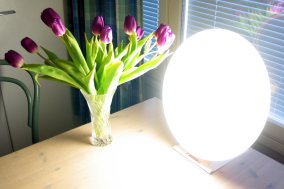 Staying happy during winter can be a challenge for some of us, when the amount of natural sunlight reduces.
Staying happy during winter can be a challenge for some of us, when the amount of natural sunlight reduces.
Our mood is directly affected by how much sunlight we receive. Many people find that they become seasonally depressed as they receive less light in winter. People are especially affected if they live in the far northern hemisphere.
How gloomy people feel during the dark, rainy season can range from mild to major seasonal depression, also known as Seasonal Affective Disorder (SAD). The good news is that there are many things we can do to help us stay happy during winter.
Dr. Alan Manevitz from the Cornell Medical Center says that 2009 is one of the worst years for SAD. Are you affected?
What is Seasonal Affective Disorder (SAD)?
Who is affected by seasonal mood changes?
Why does light affect us?
How does SAD affect our health?
What can we do to feel happy in winter?
What is Seasonal Affective Disorder (SAD)?
SAD is seasonal depression that occurs during winter. This depression can last for a few days or throughout the whole winter season. To be diagnosed with SAD you need to have the symptoms during winter over at least two years. Many more people have a milder form of SAD known as Sub-Syndromal Seasonal Affective Disorder (S-SAD).
SAD is different from the mood changes people feel as they change from their summer to winter lifestyles. People with SAD can have a range of symptoms, many of which are linked to general depression. Some common symptoms are:
- Depression
- Sleeping problems
- Low energy and fatigue
- Craving high-carbohydrate foods (such as potatoes, pasta, bread and cereals) and sweets, leading to weight gain
- Decreased concentration and memory
- Feeling grumpy
- Anxiety
- Loss of libido
- Mood swings
It’s normal to feel down for a short while, as long as you have a reason for it and you can cope okay. Things aren’t okay, however, if you have problems then as a result become isolated, drink too much alcohol, have low energy, lose your appetite, stop speaking to people or have problems concentrating and sleeping.
Watch this video with Dr. Alan Manevitz from the Cornell Medical Center about ways to combat seasonal depression.
People living in the northern hemisphere can expect depressive episodes that start around the same time each year (September to October) and end around the same time each year (March to April).
Some people can’t function normally without seeking medical and psychological help to cope with major winter depression. If you think you have SAD, talk to your doctor about treatment.
Who is affected by seasonal mood changes?
There have been a number of studies done to find the number of people with SAD, with varying results. SAD is most common in the Arctic regions. In Alaska about 25 percent of people are affected, while in USA it is about 15 percent.
Light plays an important role in happiness. As we move away from the equator we receive less light in winter because of shorter days, more clouds and rainy weather.
Number of people with SAD and S-SAD
Location SAD (%) SAD + S-SAD (%) Fairbanks, Alaska 8.9 – 9.2
24.9 – 28.3
Tromsø, Norway 13.7
24.4
New Hampshire, USA 9.7
20.7
Helsinki, Finland 7.1 – 9.5
18.9
Stockholm, Sweden 3.9
17.8
New York, USA 4.7
17.1
Maryland, USA 6.3
16.7
Reykjavik, Iceland 3.8
11.3
Florida, USA 1.4
4.0
Australia 0.3
Source: N Rosenthal MD, WinterBlues, page 64; Wikipedia, “Seasonal affective disorder”, http://en.wikipedia.org/wiki/Seasonal_affective_disorder
Why does light affect us?
Seasonal mood changes are believed to be linked to light. The exact cause of this unknown, but has been proven to exist through statistics.
There are two main theories that explain the cause of seasonal mood changes:
- It’s believed that SAD is linked to an upset in the body’s circadian rhythms, also known as our body clock.
- Light affects the body’s internal melatonin rhythm.
One possibility is that when we see bright light, the pineal gland in our brain is triggered to make more serotonin and less melatonin. Melatonin is the hormone that our body makes to help us sleep, while serotonin (a neurotransmitter) is a chemical that regulates our mood and energy.
When we don’t receive enough light, the nerve cells in our brain signal the pineal gland to make more of the hormone melatonin.
Bright light may also be important in regulating another neurotransmitter called dopamine. Dopamine helps make us happy. It may also play a role in resetting the body clock.
It’s believed that we need bright sun light every morning to reset our body clock. People with weak internal body clocks need more light to reset this clock every day. When they don’t receive this light signal, their body clocks either speeds up or slows down. This results in the wrong hormones being made at the wrong time of day, causing SAD.
How does SAD affect our health?
Apart from feeling gloomy, SAD can also suppress the immune system. This means people are likely to get more colds and flu than if they were feeling happier.
One of the possible symptoms of SAD is that we eat more high-carbohydrate foods. These can increase serotonin levels, which are low in people with SAD. This may be why people crave these foods. Eating too many high-carbohydrate foods can lead to weight gain.
What can we do to feel happy in winter?
There is a lot we can do to help cope with SAD. If you find that you are not able to cope with your daily tasks, it’s important to contact a mental health professional that can provide counselling and treatment.
1. Use light therapy
 Light therapy is daily exposure to bright artificial light. It’s important to use specially designed sun boxes. Studies show that bright light at certain times of the day can help control seasonal mood swings, improve sleeping patterns, and help us feel happier.
Light therapy is daily exposure to bright artificial light. It’s important to use specially designed sun boxes. Studies show that bright light at certain times of the day can help control seasonal mood swings, improve sleeping patterns, and help us feel happier.
Most people will benefit from treatments first thing in the morning between 7 am and 9 am. You’re likely to need the treatments if you often have problems getting up in the morning, are tired during the day, and have trouble falling asleep until 1 or 2 am. Treatments last between 15 and 30 minutes.
The timing of each treatment is important. Treatments are usually in the morning, but may be needed in the evening instead. You’re likely to need light therapy at night if you often fall asleep early, you only stay asleep for a few hours and wake up during the night not being able to get back to sleep.
People can expect improvement during the first week with increased results if used over several weeks.
2. Get daily exercise
A great way to beat seasonal depression is to get daily exercise, particularly outdoors. You may find that this is better than light therapy. Regular exercise can reduce depression by increasing serotonin levels.
In a study at Duke University, people with depression who walked for 30 minutes three times a week felt less depressed.
3. Eat healthy and avoid certain foods
Help stay healthy by avoiding sugary foods and not over eating. Healthy eating includes having plenty of whole grains, vegetables and fruit, and small amounts of high-fat, high-sugar foods.
4. Eat regular meals
Studies on jet lag, another disorder linked to our internal body clock, suggest regular meals help regulate this clock.
5. Get a pet
While pets make great friends, studies show that they are also great for reducing stress and may help treat depression and anxiety. Owning a dog will force you to go on regular walks, giving you exercise – a great stress and depression buster. You might meet other people while walking and strike up a conversation about your cute furry friend.
6.Try dawn simulation
Dawn simulation involves timing lights in the bedroom to come on gradually, over a period of 30 minutes to two hours, before waking up. In some studies, there is over 80 percent better response when compared to other bright light therapy.
Dawn simulation tricks your brain into thinking its early morning outside and it’s time to wake up.
7. Spend more time outdoors
Try to spend as much time as possible outdoors. Even a brief lunchtime walk outside can help.
8. Use color therapy
 How we feel about color is more than just in our minds. Did you know that color can affect our blood pressure, glands, electrical skin resistance, and how we feel each day?
How we feel about color is more than just in our minds. Did you know that color can affect our blood pressure, glands, electrical skin resistance, and how we feel each day?
We can use the power of color when decorating our homes. Use bright uplifting colours such as red, orange and yellow. These are warm colors that stimulate and energize us. Avoid using blue, grey and black.
9. Have herbs to help you sleep
Use herbs such as chamomile, valerian, hops or passion flower, which help you get a good night’s sleep. Herbs can have side effects and can interact with some medication, so check with a relevant health professional or do your own research before taking herbs.
10. Air ionization
Negative air ionization involves the release of charged particles into the sleep environment. This can have a nearly 50 percent improvement in symptoms of SAD.
11. Eat more fish
Icelandic people are less affected by seasonal depression. This may be caused by the large amount of fish they eat – 225 pound per person per year, as opposed to about 50 pounds in the US and Canada – rather than to genetics.
12. Control the body clock with melatonin
Research by Dr. Alfred Lewy has found that taking small amounts of melatonin in the afternoon may help regulate the body clock by bringing it forward, meaning you go to bed earlier.
13. Take a winter holiday
Take a winter holiday to a warm sunny place, where you can get plenty of natural sunlight.
written by Nyomi Graef

 August 8th, 2009
August 8th, 2009  Nyomi Graef
Nyomi Graef  Posted in
Posted in  Tags:
Tags: 

[…] Stop feeling sad this winter – how to treat winter depression … […]
[…] Stop feeling sad this winter – how to treat winter depression … […]
[…] Stop feeling sad this winter – how to treat winter depression … […]
Hi, You have some really good articles on your blog. I also like the theme and the layout as well. Nice work!
Hi there, I’m just here to tell you that I found your website when looking for sources for the subject of Seasonal Affective Disorder to find out more about it. You have some helpful information here. It really helped, thanks! I will definitely use you as a resource. If you get the chance, look at this website for more information I found about how to treat SAD (not an advertisement, I promise.) I also really found some great information here that helped: http://www.firehow.com/2010042412588/how-to-deal-with-sad-seasonal-affective-disorder.html Anyways, just saying thank you. Have a nice day, I look forward to any future information from your site.
Winter depression can be such a difficult thing to deal with when you live in the northern states with those short days and long nights, barely seeing any sunlight. I’ve been seeing a lot lately about how exercise and sunlight can really help “wake you up” from that dreariness. I just saw a video on you tube called “Beating the Blues with Exercise Light Therapy” http://youtu.be/jRmu-5-05sk on the InsidersHealth channel. It combines light and exercise to help conquer S.A.D, what a great idea!